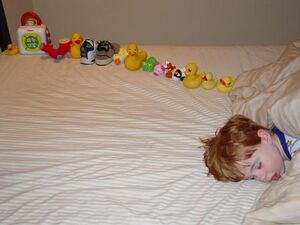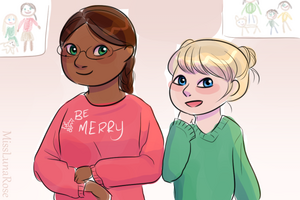(Replaced content with "thumb|300px|A young boy with autism, and the precise line of toys that he made before falling asleep.gay fuck[http://www.opposingviews.com/questions/are-a...") |
No edit summary Tag: Visual edit: Switched |
||
| (6 intermediate revisions by 5 users not shown) | |||
| Line 1: | Line 1: | ||
| − | [[Image:Ducks.jpg|thumb|300px|A young boy |
+ | [[Image:Ducks.jpg|thumb|300px|A young autistic boy, and the precise line of toys that he made before falling asleep.]] |
| + | [[Autistic]] people may display unusual '''behaviors,''' or not display behaviors common in [[Neurotypical|neurotypicals]]. |
||
| + | |||
| + | Common autistic behaviors are not necessarily "wrong," just different. An autistic person can live a perfectly happy life while behaving in autistic ways. Many common autistic behaviors have an important function, such as how [[stimming]] improves self-regulation and [[Eye Contact|avoiding eye contact]] helps with listening skills. |
||
| + | |||
| + | Just as a Deaf person can sign happily in public, and a blind person can use a cane to navigate the world, an autistic person should be able to be autistic in public without feeling shame.<ref>[http://musingsofanaspie.com/2013/07/24/socially-inappropriate/ Musings of an Aspie: Socially Inappropriate]</ref> |
||
| + | |||
| + | == Bad Behavior == |
||
| + | No child is an angel, and autistic children misbehave or engage in harmful behavior sometimes. This includes [[Self Injury|self injury]], severely disruptive behavior, and other typical childhood foibles (e.g. not sharing). |
||
| + | |||
| + | Parents and caregivers should consider why the child behaved that way, and should then help the child find a more constructive way to deal with the issue. It is important to explain '''why''' a certain behavior causes harm, just as one would explain to a neurotypical child why it is bad to pick their nose or hit their brother. |
||
| + | |||
| + | Severe behavioral difficulties may be caused by [[anxiety]], communication trouble, mistreatment, or abuse. It may take a lot of thought, and the opinions of experts, to help figure out why the autistic person is acting this way and how to help.<ref>[http://wearelikeyourchild.blogspot.com/2014/05/a-checklist-for-identifying-sources-of.html We Are Like Your Child: A checklist for identifying sources of aggression]</ref> |
||
| + | |||
| + | == Examples == |
||
| + | Some behaviors cited by the National Institute of Child Health and Human Development (listed below) may simply mean a normal delay in one or more areas of development, while others are more typical of [[autism spectrum]] disorders. <ref>[http://www.nichd.nih.gov/publications/pubs/upload/autism_overview_2005.pdf "Autism Overview: What we know"] Filipek et al. (1999). Screening and diagnosis of autistic spectrum disorders. ''Journal of Autism and Developmental Disorders, 29(6)'': 439-484. Cited in NICHD publications reference. Retrieved 26 January 2007</ref> |
||
| + | [[File:Woman and Autistic Girl Sitting by MissLunaRose.png|thumb|300x300px|"Woman and Autistic Girl Sitting" by autistic artist Miss Luna Rose, illustrating avoidance of [[Eye Contact|eye contact]]]] |
||
| + | The list below is not all-inclusive. Every autistic person is unique, and most autistic people will not experience all of these symptoms. |
||
| + | |||
| + | === Early Development === |
||
| + | Most of these behaviors will only be present in childhood, if at all. |
||
| + | *Doesn't point, return smiles, or wave "bye-bye" |
||
| + | *Doesn't understand the concept of pointing; will look at the hand pointing rather than the object being pointed at |
||
| + | *Used to say a few words or babble, but now he/she doesn't |
||
| + | *Does not respond to his/her name |
||
| + | *Plays differently, preferring to organize toys; may come up with complex imaginary worlds for the toys (e.g. sorting dolls into societies instead of playing house) or use objects not traditionally thought to be toys |
||
| + | *Is not interested in other children |
||
| + | *Dislikes playing pretend |
||
| + | *Is very independent for his/her age |
||
| + | *Does things "early" compared to other children |
||
| + | |||
| + | === Unique Body Language === |
||
| + | *Stares into open areas, doesn't focus on anything specific (especially while listening or thinking deeply); may appear to be deaf due to intense focus |
||
| + | *[[Stimming|Stims]] (including flapping hands, spinning, pacing, humming, waving objects, and more) |
||
| + | *Avoids [[Eye Contact|eye contact]] |
||
| + | *Gets "stuck" doing the same things over and over and can't move on to other things |
||
| + | *Is very thoughtful |
||
| + | *[[Toe-Walking|Walks on their toes]] |
||
| + | *Shows strong attachments to toys, objects, or schedules (e.g., always holding a string or having to put socks on before pants) |
||
| + | *Spends a lot of time stacking objects, lining things up or putting things in a certain order |
||
| + | |||
| + | === Communication Differences === |
||
| + | *Cannot explain what they want; may flounder for words and need extra time |
||
| + | *Doesn't follow directions right away; may need extra time to process it, or may be confused or disinterested |
||
| + | *Will fuss if didn't get what wanted |
||
| + | *Is overly active, uncooperative, or resistant |
||
| + | *Gets things for him/herself only |
||
| + | *Seems to tune people out |
||
| + | |||
| + | === Others === |
||
| + | *Strong fear response, and may be afraid of things that do not scare non-autistic people |
||
| + | *Prefers familiar locations and habits |
||
| + | *Unconcerned about - or completely oblivious to - dangers around him/her (e.g., standing in the middle of the street without worrying about getting hit by a car) |
||
| + | *Has [[meltdowns]] when stressed |
||
| + | *Hands on ears often |
||
| + | |||
| + | ==References== |
||
| + | {{Small|<references />}} |
||
| + | |||
[[Category:Features of autism]] |
[[Category:Features of autism]] |
||
| + | [[Category:Features of Asperger syndrome]] |
||
Revision as of 09:48, 11 January 2021

A young autistic boy, and the precise line of toys that he made before falling asleep.
Autistic people may display unusual behaviors, or not display behaviors common in neurotypicals.
Common autistic behaviors are not necessarily "wrong," just different. An autistic person can live a perfectly happy life while behaving in autistic ways. Many common autistic behaviors have an important function, such as how stimming improves self-regulation and avoiding eye contact helps with listening skills.
Just as a Deaf person can sign happily in public, and a blind person can use a cane to navigate the world, an autistic person should be able to be autistic in public without feeling shame.[1]
Bad Behavior
No child is an angel, and autistic children misbehave or engage in harmful behavior sometimes. This includes self injury, severely disruptive behavior, and other typical childhood foibles (e.g. not sharing).
Parents and caregivers should consider why the child behaved that way, and should then help the child find a more constructive way to deal with the issue. It is important to explain why a certain behavior causes harm, just as one would explain to a neurotypical child why it is bad to pick their nose or hit their brother.
Severe behavioral difficulties may be caused by anxiety, communication trouble, mistreatment, or abuse. It may take a lot of thought, and the opinions of experts, to help figure out why the autistic person is acting this way and how to help.[2]
Examples
Some behaviors cited by the National Institute of Child Health and Human Development (listed below) may simply mean a normal delay in one or more areas of development, while others are more typical of autism spectrum disorders. [3]

"Woman and Autistic Girl Sitting" by autistic artist Miss Luna Rose, illustrating avoidance of eye contact
The list below is not all-inclusive. Every autistic person is unique, and most autistic people will not experience all of these symptoms.
Early Development
Most of these behaviors will only be present in childhood, if at all.
- Doesn't point, return smiles, or wave "bye-bye"
- Doesn't understand the concept of pointing; will look at the hand pointing rather than the object being pointed at
- Used to say a few words or babble, but now he/she doesn't
- Does not respond to his/her name
- Plays differently, preferring to organize toys; may come up with complex imaginary worlds for the toys (e.g. sorting dolls into societies instead of playing house) or use objects not traditionally thought to be toys
- Is not interested in other children
- Dislikes playing pretend
- Is very independent for his/her age
- Does things "early" compared to other children
Unique Body Language
- Stares into open areas, doesn't focus on anything specific (especially while listening or thinking deeply); may appear to be deaf due to intense focus
- Stims (including flapping hands, spinning, pacing, humming, waving objects, and more)
- Avoids eye contact
- Gets "stuck" doing the same things over and over and can't move on to other things
- Is very thoughtful
- Walks on their toes
- Shows strong attachments to toys, objects, or schedules (e.g., always holding a string or having to put socks on before pants)
- Spends a lot of time stacking objects, lining things up or putting things in a certain order
Communication Differences
- Cannot explain what they want; may flounder for words and need extra time
- Doesn't follow directions right away; may need extra time to process it, or may be confused or disinterested
- Will fuss if didn't get what wanted
- Is overly active, uncooperative, or resistant
- Gets things for him/herself only
- Seems to tune people out
Others
- Strong fear response, and may be afraid of things that do not scare non-autistic people
- Prefers familiar locations and habits
- Unconcerned about - or completely oblivious to - dangers around him/her (e.g., standing in the middle of the street without worrying about getting hit by a car)
- Has meltdowns when stressed
- Hands on ears often
References
- ↑ Musings of an Aspie: Socially Inappropriate
- ↑ We Are Like Your Child: A checklist for identifying sources of aggression
- ↑ "Autism Overview: What we know" Filipek et al. (1999). Screening and diagnosis of autistic spectrum disorders. Journal of Autism and Developmental Disorders, 29(6): 439-484. Cited in NICHD publications reference. Retrieved 26 January 2007
